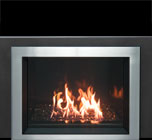
The Chimney Sweep Online Fireplace, Woodstove, Gas Stove and Barbecue Shop

The Chimney Sweep Online Fireplace, Woodstove, Gas Stove and Barbecue Shop
To exit the table, close this window
| MODEL | DIMEN- SIONS |
INPUT MINIMUM (BTU/HR) |
INPUT MAXIMUM (BTU/HR) |
OVERALL HEATING EFFICIENCY |
OUTPUT MINIMUM (BTU/HR) |
OUTPUT MAXIMUM (BTU/HR) |
MAXIMUM HEATING CAPACITY |
VIEWING WINDOW SIZE (SQ.IN.) | |
 |
PACIFIC ENERGY TOFINO i30 INSERT | 32"W 17-3/8"D 21-5/8"T | NG 15,000 LP 15,000 | NG 30,000 LP 30,000 | 71.1% | NG 10,665 LP 10,665 | NG 21.330 LP 21,330 | UP TO 1,500 Sq Ft |
 |
 |
SOLAS TWENTY6 FI | 29-3/4"W 14-1/4"D 20-1/2"T | NG 14,000 LP 16,000 | NG 19,500 LP 19,500 | 79% | NG 11,060 LP 12,640 | NG 15,405 LP 15,405 | UP TO 1,000 Sq Ft |
 |
 |
PACIFIC ENERGY TOFINO i20 INSERT | 28-1/2"W 17-3/8"D 19-3/8"T | NG 6,000 LP 7,000 | NG 20,000 LP 20,000 | 74.1% | NG 4,446 LP 5,187 | NG 14,820 LP 14,820 | UP TO 1,000 Sq Ft |
 |
NOTESINPUT RATINGS:
|